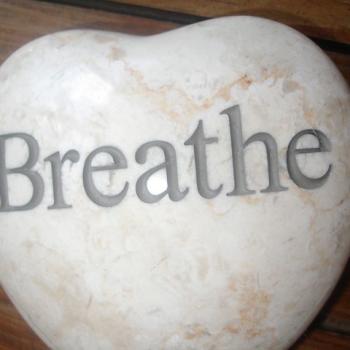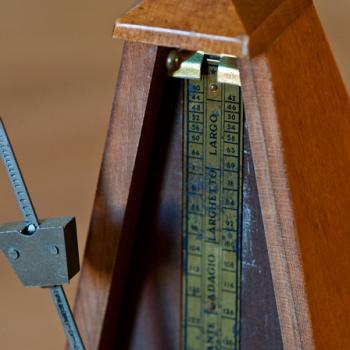
Getting In Our Own Way
Listening to sacred stillness is about more than just being calm and sitting still. We need to learn how to stay out of our own way.
It can be easy for us to get stuck in our image of sitting quietly. We see the challenge as meeting our goal of five minutes or twenty minutes of stillness. The truly important part is our openness, our willingness to listen.
This is not a test or competition or anything else we can measure. We are the only ones evaluating our performance.
Many of us create our own obstacles and get in our own way.
The challenge for us is about getting, and staying, out of our own way.
It is as if we were wrestling with ourselves, struggling for control of our own minds. We act as if we need to dominate or eliminate our own thoughts.
Some of us find sacred stillness challenging because we are intimidated. We may feel nervous or afraid about facing the truths within us, our inner selves.
Others of us experience stillness as boring. We have a difficult time not paying attention to distracting thoughts or feelings. As we begin to recognize sacred stillness we remember all the things we meant to do before we began. There are so many things we need to do seeking our attention.
Do we really have time to sit still right now?
Our challenge is not actually with sacred stillness. We long to be immersed in its loving presence.
The challenge for us is getting in our own way. There is more we need to accomplish before we have earned stillness in our lives. We are worried it may demand more from us than we are willing, or able, to give.
Moving Out of Our Own Way
It is as if we have already decided we are not worthy of sacred stillness. We apparently have a carefully constructed set of defenses to keep us away from its power.
There are expectations we have inherited from other people. We may have formed opinions without examining them particularly deeply. Some of us make assumptions based on what we hear from other people.
Our experiences shape our perspectives, which influence how we experience things.
We may not actually try to misunderstand, but we often do not try particularly hard to understand, either. Like everyone else, we make assumptions based on our own experiences.
I learned lessons about life before I was even able to put them into words. I have a view of how life works which comes from where, and how, I was raised.
My life and experiences have taught me to question many of those early lessons since then. I have met and gotten to know people whose stories are different from mine. Reading and reflecting on ideas which were new to me has changed my thinking.
Every so often I run into one of those deeply held, long buried lessons from long ago.
Stillness is not powerful merely because it is quiet. Sacred stillness gives us opportunities to listen and reflect on who we truly are. We spend time opening up to possibilities and recognizing what we might reconsider.
Staying Out of Our Own Way
Some of the obstacles we put in our own way block us from exploring sacred stillness.
Spending time in sacred stillness is quite different from how we usually live. Beginning to make the change requires our intention and our practice. We each need to overcome our own challenges.
Exploring sacred stillness begins with our curiosity and openness. We intend to discover and welcome our true selves and to find our own way. Some of us have tried many other paths. Now we are ready to explore more deeply.
It is helpful to describe how we will begin our practice. Many people decide to begin by spending 20 minutes in stillness once or twice a day. Setting our terms will allow us to put our expectations to work helping us.
Setting our terms is not designed to make us feel ashamed or guilty if we do not always meet them. We are describing our practice to make our intention clearer. It is not a matter of failing or succeeding.
Remember, we are the only ones evaluating our performance.
It is also helpful to remember it is not our intention to become perfect at practicing. We set our terms so we will be realistic, to encourage ourselves to practice and reflect.
We intend to practice listening to sacred stillness. It is important for us to get, and stay, out of our own way. When we realize we are in the way again, we want to step back out as gently as we can.
We want to remember it is the stillness which is sacred.
Finding Our Own Way
The stillness we are seeking is not magic. When we take the time to listen to stillness we allow ourselves to hear sacred truths.
I believe the power of sacred truth is all around us, and within us. We rarely take the time to listen, to open ourselves to what is sacred in our lives.
It becomes easy for us to pay attention to other things in our lives and ignore what is sacred.
We allow ourselves to be distracted by our thoughts and feelings, by ideas and sensations. Our world is full of distractions and we let ourselves skim along the surface of life.
We learn not to distract ourselves by listening to sacred stillness.
Listening to sacred stillness is how we can create opportunities to go deeper.
When will we find ways to get out of our own way today?
How will we stay out of our own way this week?
[Image by spcbrass]
Greg Richardson is a spiritual director in Southern California. He is a recovering assistant district attorney and associate university professor, and is a lay Oblate with New Camaldoli Hermitage near Big Sur, California. Greg’s website is StrategicMonk.com and his email address is [email protected].












